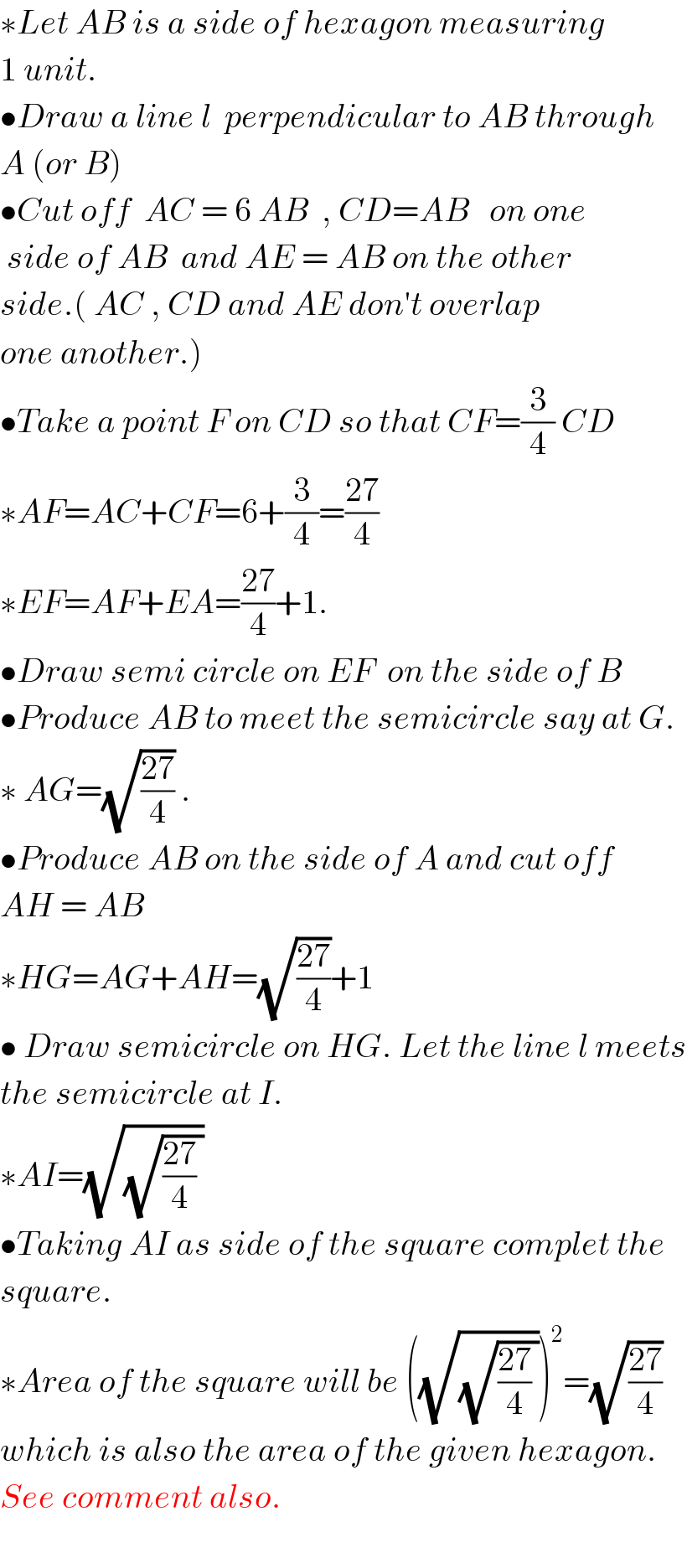
Question Number 3644 by prakash jain last updated on 17/Dec/15

$$\mathrm{An}\:\mathrm{hexagon}\:\mathrm{of}\:\mathrm{unit}\:\mathrm{side}\:\mathrm{is}\:\mathrm{drawn}\:\mathrm{on}\:\mathrm{plane}. \\ $$$$\mathrm{Draw}\:\mathrm{a}\:\mathrm{square}\:\mathrm{having}\:\mathrm{the}\:\mathrm{same}\:\mathrm{area}\:\mathrm{as}\:\mathrm{the} \\ $$$$\mathrm{hexagon}\:\mathrm{using}\:\mathrm{only}\:\mathrm{unmarked}\:\mathrm{ruler}\:\mathrm{and}\: \\ $$$$\mathrm{compass}. \\ $$$$\mathrm{What}\:\mathrm{if}\:\mathrm{an}\:{n}−\mathrm{gon}\:\mathrm{with}\:\mathrm{unit}\:\mathrm{edges}\:\mathrm{is}\:\mathrm{given}? \\ $$$$\mathrm{Is}\:\mathrm{it}\:\mathrm{always}\:\mathrm{possible}\:\mathrm{to}\:\mathrm{draw}\:\mathrm{a}\:\mathrm{square} \\ $$$$\mathrm{of}\:\mathrm{the}\:\mathrm{same}\:\mathrm{area}\:\mathrm{as}\:{n}−\mathrm{gon}\:\mathrm{using}\:\mathrm{ruler} \\ $$$$\mathrm{and}\:\mathrm{compass}. \\ $$
Commented by Rasheed Soomro last updated on 17/Dec/15

$$\mathrm{A}\:\mathrm{hexagon}\:\mathrm{of}\:\mathrm{unit}\:\mathrm{side}\:\mathrm{consists}\:\mathrm{of}\:\mathrm{6} \\ $$$$\mathrm{triangles}\:\mathrm{of}\:\mathrm{unit}\:\mathrm{side}. \\ $$$$\mathrm{Area}\:\mathrm{of}\:\:\mathrm{triangle}\:\mathrm{of}\:\mathrm{unit}\:\mathrm{side}\left(\blacktriangle\right)\:: \\ $$$$\:\:\:\:\:\:\:\blacktriangle=\sqrt{\frac{\mathrm{3}}{\mathrm{2}}\left(\frac{\mathrm{3}}{\mathrm{2}}−\mathrm{1}\right)^{\mathrm{3}} }=\sqrt{\frac{\mathrm{3}}{\mathrm{2}}×\frac{\mathrm{1}}{\mathrm{2}^{\mathrm{3}} }} \\ $$$$\:\:\:\:\:\:\:\:\:\:\:=\frac{\sqrt{\mathrm{3}}}{\mathrm{4}} \\ $$$$\mathrm{Area}\:\mathrm{of}\:\mathrm{hexagon}\:\mathrm{of}\:\mathrm{unit}\:\mathrm{side}\:\left(\mathrm{A}\right):\:\:\: \\ $$$$\:\:\:\:\:\:\mathrm{A}=\mathrm{6}\blacktriangle=\mathrm{6}×\frac{\sqrt{\mathrm{3}}}{\mathrm{4}}=\frac{\mathrm{3}\sqrt{\mathrm{3}}}{\mathrm{2}}=\sqrt{\frac{\mathrm{27}}{\mathrm{4}}} \\ $$$$\mathrm{Square}\:\mathrm{of}\:\mathrm{area}\:\frac{\mathrm{3}\sqrt{\mathrm{3}}}{\mathrm{2}}\:\mathrm{has}\:\mathrm{its}\:\mathrm{side}\left(\mathrm{s}\right)\:\mathrm{equal}\:\mathrm{to} \\ $$$$\:\:\:\:\:\:\:\:\sqrt{\sqrt{\frac{\mathrm{27}}{\mathrm{4}}}} \\ $$$$\mathrm{So}\:\mathrm{ultimately}\:\mathrm{we}\:\mathrm{need}\:\mathrm{to}\:\mathrm{draw}\:\mathrm{a}\:\mathrm{line}\:\mathrm{segment}\:\mathrm{of} \\ $$$$\mathrm{measure}\: \\ $$$$\:\:\:\:\:\:\:\:\:\:\:\:\:\:\:\:\:\:\:\:\:\:\sqrt{\sqrt{\frac{\mathrm{27}}{\mathrm{4}}}}\:\:\:\:\:\mathrm{units} \\ $$$$\mathrm{One}\:\mathrm{way}\:\mathrm{may}\:\mathrm{be}\:\mathrm{as}\:\mathrm{under}: \\ $$$$\bullet\mathrm{Extend}\:\mathrm{the}\:\mathrm{side}\:\mathrm{of}\:\mathrm{hexagon}\:\mathrm{27}\:\mathrm{times}.\:\mathrm{Say}\:\mathrm{it}\:\mathrm{AB} \\ $$$$\bullet\:\mathrm{Cut}\:\mathrm{off}\:\mathrm{AC}=\frac{\mathrm{1}}{\mathrm{4}}\mathrm{AB}\:\:. \\ $$$$\bullet\mathrm{Cut}\:\mathrm{off}\:\mathrm{CD}\:\mathrm{equal}\:\mathrm{to}\:\mathrm{hexagon}\:\mathrm{side}\:\mathrm{from}\:\mathrm{AB}. \\ $$$$\mathrm{Continue} \\ $$
Answered by Rasheed Soomro last updated on 19/Dec/15

$$\ast{Let}\:{AB}\:{is}\:{a}\:{side}\:{of}\:{hexagon}\:{measuring} \\ $$$$\mathrm{1}\:{unit}. \\ $$$$\bullet{Draw}\:{a}\:{line}\:{l}\:\:{perpendicular}\:{to}\:{AB}\:{through} \\ $$$${A}\:\left({or}\:{B}\right)\: \\ $$$$\bullet{Cut}\:{off}\:\:{AC}\:=\:\mathrm{6}\:{AB}\:\:,\:{CD}={AB}\:\:\:{on}\:{one} \\ $$$$\:{side}\:{of}\:{AB}\:\:{and}\:{AE}\:=\:{AB}\:{on}\:{the}\:{other} \\ $$$${side}.\left(\:{AC}\:,\:{CD}\:{and}\:{AE}\:{don}'{t}\:{overlap}\right. \\ $$$$\left.{one}\:{another}.\right)\: \\ $$$$\bullet{Take}\:{a}\:{point}\:{F}\:{on}\:{CD}\:{so}\:{that}\:{CF}=\frac{\mathrm{3}}{\mathrm{4}}\:{CD} \\ $$$$\ast{AF}={AC}+{CF}=\mathrm{6}+\frac{\mathrm{3}}{\mathrm{4}}=\frac{\mathrm{27}}{\mathrm{4}} \\ $$$$\ast{EF}={AF}+{EA}=\frac{\mathrm{27}}{\mathrm{4}}+\mathrm{1}. \\ $$$$\bullet{Draw}\:{semi}\:{circle}\:{on}\:{EF}\:\:{on}\:{the}\:{side}\:{of}\:{B} \\ $$$$\bullet{Produce}\:{AB}\:{to}\:{meet}\:{the}\:{semicircle}\:{say}\:{at}\:{G}. \\ $$$$\ast\:{AG}=\sqrt{\frac{\mathrm{27}}{\mathrm{4}}}\:. \\ $$$$\bullet{Produce}\:{AB}\:{on}\:{the}\:{side}\:{of}\:{A}\:{and}\:{cut}\:{off}\: \\ $$$${AH}\:=\:{AB} \\ $$$$\ast{HG}={AG}+{AH}=\sqrt{\frac{\mathrm{27}}{\mathrm{4}}}+\mathrm{1} \\ $$$$\bullet\:{Draw}\:{semicircle}\:{on}\:{HG}.\:{Let}\:{the}\:{line}\:{l}\:{meets} \\ $$$${the}\:{semicircle}\:{at}\:{I}. \\ $$$$\ast{AI}=\sqrt{\sqrt{\frac{\mathrm{27}}{\mathrm{4}}\:}} \\ $$$$\bullet{Taking}\:{AI}\:{as}\:{side}\:{of}\:{the}\:{square}\:{complet}\:{the} \\ $$$${square}. \\ $$$$\ast{Area}\:{of}\:{the}\:{square}\:{will}\:{be}\:\left(\sqrt{\sqrt{\frac{\mathrm{27}}{\mathrm{4}}\:}}\right)^{\mathrm{2}} =\sqrt{\frac{\mathrm{27}}{\mathrm{4}}} \\ $$$${which}\:{is}\:{also}\:{the}\:{area}\:{of}\:{the}\:{given}\:{hexagon}. \\ $$$${See}\:{comment}\:{also}. \\ $$$$ \\ $$
Commented by Rasheed Soomro last updated on 17/Dec/15

$${n}−{gon}\:\:{can}\:{be}\:\boldsymbol{\mathrm{squared}}\:{only}\:{when}\:\mathrm{sin}\:\frac{\mathrm{2}\pi}{{n}}\:{can} \\ $$$${be}\:{expressed}\:\:{as}\:{rationals}\:{or}\:{surds}\:{containing} \\ $$$${only}\:{squareroots}. \\ $$
Commented by prakash jain last updated on 17/Dec/15

$$\mathrm{It}\:\mathrm{is}\:\mathrm{correct}\:\mathrm{that}\:\mathrm{not}\:\mathrm{all}\:{n}−\mathrm{gon}\:\mathrm{can}\:\mathrm{be}\:\mathrm{squared}. \\ $$
